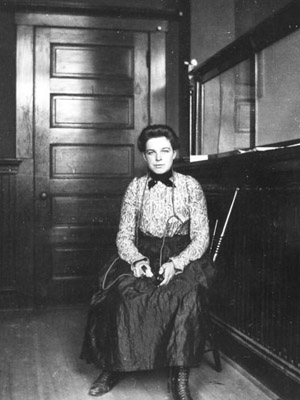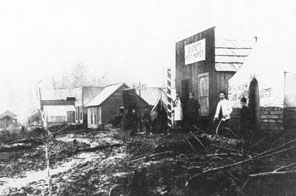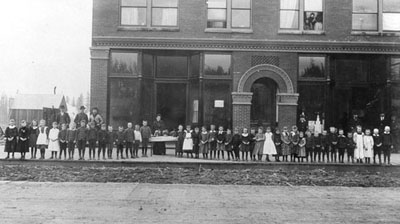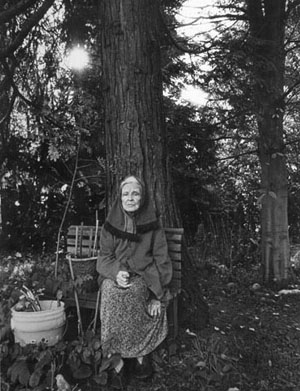
www.snohomishwomenslegacy.org WLP Story # 36 ~ |
 Eva Jones Davis as Phone operator, circa 1903
|
Eva Jones
Davis---Everett Pioneer By Margaret Riddle One stormy summer day in 1891, Mary Jones and her eight-year-old daughter Eva boarded a small steamer in Olympia and journeyed north. A newly built one-room house was waiting for them, near the Snohomish River, at a place that would soon be called Everett, Washington. From the start, Eva and her family considered themselves “pioneers." Traveling to Washington State by train from the Midwest, the Joneses first settled in Chehalis, then Olympia, and finally Everett, a pattern that, in variation, was repeated by hundreds of new arrivals to the Pacific Northwest over the next twenty years. For many, the journey was a movement west. For others the journey was south or north or east, depending on their place of origin. Their experiences were as diverse as their numbers. What they held in common was a strong sense of independence and the dream of improving their lives. Many, like the Joneses, came with adventure in their hearts. Eva’s father Bert Jones, a
millwright, had arrived earlier to help install
machinery for a paper mill in Lowell (now part of
Everett) and a concentrator for the mining town of
Monte Cristo, east of town in the Cascade Mountains.
|
| Recalling her childhood memories of that day nearly eighty years before, Eva told what she had seen when she first arrived. The town wasn’t really a town yet. Mostly it resembled a battle field strewn with stumps, mud and bogs. Few families had arrived. Eva and her mother may have thought of the challenges ahead trying to live in such a primitive place. The only people Eva saw were workers clearing the land and others who came to sell goods and lodging to the workers. There was a general store and post office on the bayside and a grocery, a cigar stand and a hotel near the river. Eva recalled seeing their makeshift, temporary structures. Some had tent roofs. Workers cut trees, cleared land and burned stumps, prompting one journalist to describe the town site as “an inferno where smoke filled the air and smoldering stumps glowed red at night.” |  Everett Townsite, 1891, courtesy of Everett Public Library, Everett, WA |

By the fall
of 1891, there were enough children at the town site to
start a school. Temporary classrooms were set up in the Brue
Building on Everett Avenue. Eva’s best friend and playmate
was neighbor Gracie Spithill whose grandfather and
grandmother had homesteaded years before the city of Everett
was imagined. Gracie was part Scot and part Snohomish
Indian. While Eva was to live a long life, Gracie died as a
child.
Photo left - Eva and
the Brue building school, circa 1890s, courtesy Everett
Public Library Northwest Room
Eva quickly learned to care for herself since her father was often at Monte Cristo and her mother was a midwife who sometimes was away for days delivering babies. Mary Jones trusted in home remedies and Eva continued to use her mother’s recipes throughout her life. She made her own cough syrup and remembered once making a salve that helped to save a young boy’s injured leg. When asked what ingredients she used, Eva replied “That’s a long story. We were standing on the ocean beach in Oregon. And we see something shining way out in the water. Well the tide was coming and that tin came to us and it was a jar of Stockholm tar. Of course it was runny and I didn’t know what to mix with it, so I got Vaseline and melted the Vaseline and mixed half and half and made a salve out of it. It was a gallon can and it lasted a long time.”
As a young woman, Eva was a telephone operator. It was here that she met James H. Davis, a lineman who came to town with a traveling work crew stringing telephone lines. Eva and James began dating and married in 1903. The couple lived in the Jones’s family home for four years and Eva gave birth to their first child, a daughter. The Davises eventually had a home of their own on riverside and a son was born.
 Margaret Riddle
and David Dilgard of the Everett Public Library and shortly before her death,
photographer Carolyn Kozo Cole took pictures of her [see photo to the right]. Eva described herself as a
“homebody”, a person who “didn’t neighbor much.” She was not involved in church
or club activities. Her life revolved instead around her home and her family.
Since arriving in Everett, she had lived in only two houses and both were on
Everett’s riverside. Her home was filled with treasures from the past including
cyanotype photos made by an aunt which were then printed on 4” x 5” pieces of
cloth and quilted as pillows. There are quite a lot of Everett pictures in
there,” Eva had said. “I’ve had those for years and years and years…..they never
fade.” When Eva reminisced, she occasionally pointed to an item that reminded
her of someone from the past, such as a clock that once belonged to early
pioneer and bicycle shop owner Arthur Baily.
Margaret Riddle
and David Dilgard of the Everett Public Library and shortly before her death,
photographer Carolyn Kozo Cole took pictures of her [see photo to the right]. Eva described herself as a
“homebody”, a person who “didn’t neighbor much.” She was not involved in church
or club activities. Her life revolved instead around her home and her family.
Since arriving in Everett, she had lived in only two houses and both were on
Everett’s riverside. Her home was filled with treasures from the past including
cyanotype photos made by an aunt which were then printed on 4” x 5” pieces of
cloth and quilted as pillows. There are quite a lot of Everett pictures in
there,” Eva had said. “I’ve had those for years and years and years…..they never
fade.” When Eva reminisced, she occasionally pointed to an item that reminded
her of someone from the past, such as a clock that once belonged to early
pioneer and bicycle shop owner Arthur Baily.
Eva loved to garden and each plant in her
yard had its own story. Less a feat of professional
gardening than a personal statement, Eva’s property had the
look of land that has been cared for over many years by the
same person. One glorious cedar tree dominating her back
yard had been planted by Eva when she was young.
Throughout her long life Eva Laura Jones Davis had never
“doctored much.” When at 97 years of age she was diagnosed
with cancer, she simply said to a granddaughter “Take me
home”, which is where she died on March 21, 1980. When asked
for her secret to a long life, she replied “I haven’t any
secret. I’m just allowed to live this long and I like it. I
have seven grandchildren, twelve great grandchildren and
eight great-great grandchildren, so that makes me a great
lady!”